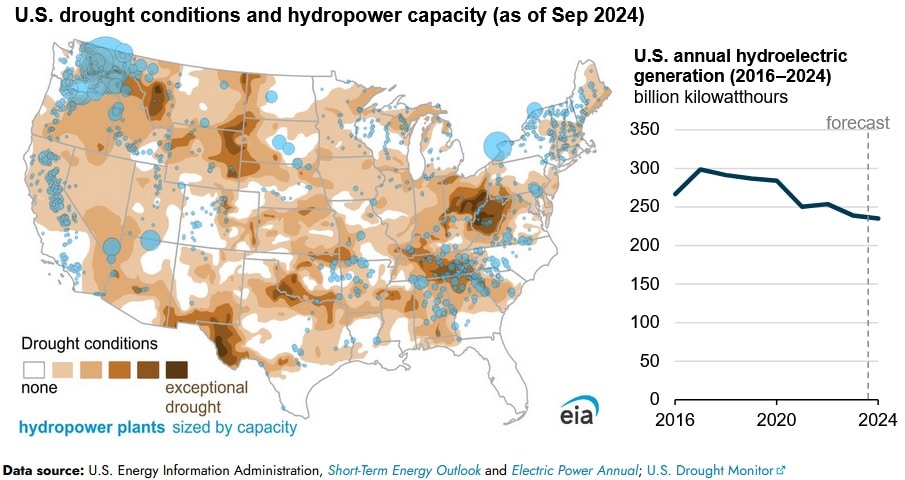U.S. Hydropower Generation Expected to Be Lower During 2024 Due to Drought Conditions: EIA

U.S. electricity production from hydroelectric plants is expected to be 13 percent lower during 2024 than the 10-year average, according to a Nov. 7 report published by the U.S. Energy Information Administration. If realized this will be the lowest volume of electricity produced from hydropower since 2001. The decrease in hydropower generation can be attributed to extreme and exceptional drought conditions affecting various regions of the U.S., particularly in the Pacific Northwest, where the majority of the U.S. hydropower capacity is based.
The most recent forecast is in contrast with the agency’s previous projection stated on April 18,2 024. The agency had previously forecast hydropower to rise six percent and account for 250 billion kilowatthours of electricity generation in the power sector.
Nearly 73 percent of the continental U.S. was undergoing drier than normal to exceptional drought conditions in September. This value rose to just over 87 percent in October. A number of regions are impacted by drought conditions, and the impact on hydropower production is more evident in the Pacific Northwest.
The Pacific Northwest’s Columbia River is one of largest rivers in the U.S. by volume. The Columbia River Basin spans significant portions of four states: Idaho, Oregon, Washington, and Montana. A number of large U.S. hydropower dams are located in the basin, such as the Chief Joseph and Grand Coulee.
The Washington State Department of Ecology announced that the majority of the counties in the state were under drought during April. Moreover, in Oregon two counties announced a drought emergency during the summer. The Dallas Dam is considered a reliable benchmark of water supply conditions in the upper Columbia River. As of the end of September, water supply at the dam was recorded at 74 percent of the 30-year summer seasonal normal.
The agency projects hydropower generation in the Northwest electricity region to be 101.8 billion kilowatthours during 2024, down one percent compared to 2023 and 23 percent lower than the 10-year average of 132 billion kilowatthours.
EnerKnol Pulses like this one are powered by the EnerKnol Platform—the first comprehensive database for real-time energy policy tracking. Sign up for a free trial below for access to key regulatory data and deep industry insights across the energy spectrum.
ACCESS FREE TRIAL